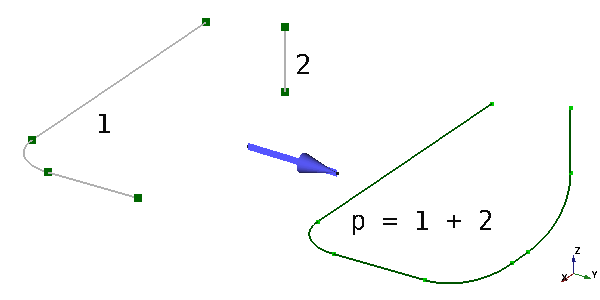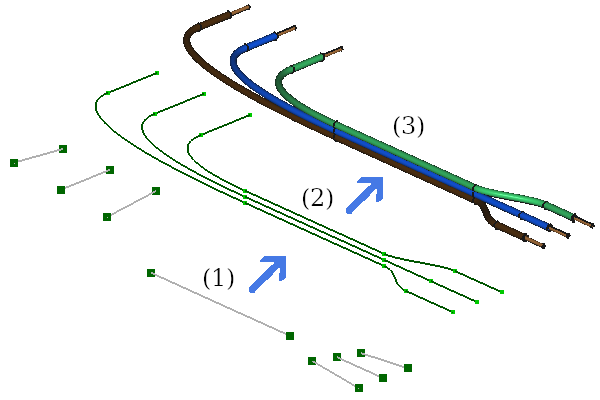Cables CompoundPath
|
|
| Menu location |
|---|
| Cable Wires → CompoundPath |
| Workbenches |
| Cables |
| Default shortcut |
| C P |
| Introduced in version |
| 0.2.0 |
| See also |
| Cables WireFlex |
Description
The CompoundPath command is designed to create a wire object based on a group of other wire objects. Its topological shape is a compound of wire shapes or a single wire shape.
It is possible to use CompoundPath as a base for Cable or CableConduit. Proper combination of WireFlex and CompoundPath can be used to simplify process of creation complex cable bundles or cables inside cable conduits avoiding unnecessary redundant base wires. Single WireFlex object can be a part of a few different CompoundPath objects influencing their shapes.
The below example ilustrates the main purpose and possibilities of CompoundPath object. The source example file can be downloaded from here: compoundPath_Test2.FCStd.
CompoundPath built of two distant wires
The CompoundPath cannot be directly edited like WireFlex. Its shape is a result of algorithms behind the Path Type property values: Complex, Wire or Simple and other additional properties processing its base wires declared under Links property.
Path Type: Complex
The Path Type:Complex algorithm creates a single wire shape based on all objects listed in Links property and partially on their Points property. Therefore, the use of this algorithm is possible only if all base objects listed in Links have Points property. Otherwise it will fail. Additionally the algorithm uses other properties "guessing" user intentions to create the desired shape.
Here are some rules used by the algorithm:
- Gaps between base objects are allowed. They will be connected automatically with lines and arcs or Bézier curve. A smaller distance between ends of base objects is chosen to create the connection.
- Direction of single base object is not important. The base objects will be connected in the order in the Links property.
- If there is no gap between base objects the connection will be corrected with arc fillets.
- If connection offset properties are used the boundary edges of base objects are shifted to reach the offset point.
- If two consecutive line edges form a single line they are replaced by a single edge.
- Tangency is preserved across all connections if possible (e.g. if MinimumFilletRadius allows it).
Path Type: Wire
The Path Type:Wire algorithm creates a single wire shape from Points property of all objects listed in Links property. Therefore, the use of this algorithm is possible only if all base objects listed in Links have Points property. Otherwise it will fail. It produces a wire shape based on a given points which is similar to what the command ![]() Draft Wire would do.
Draft Wire would do.
The rules used by the algorithm are similar to those used by the Path Type:Complex with the exception of a Bézier curve usage. The only allowed edge shapes in this mode are lines and arcs. If base object contains other shapes (e.g. BSpline), they will be replaced by the above two.
Path Type: Simple
The Path Type:Simple algorithm creates a compound of wire shapes listed in Links property. It produces exactly the same result like the command Part Compound would do.
Here any wire like objects (see Note 1) can be used as a base for CompoundPath shape not guaranteeing the success of producing the right wire to be useful as a base for a Cable or CableConduit. To successfully create such a wire (for CableConduit) the base shapes have to touch with their end vertices and additionally (to be useful as a base for Cable) they have to be properly ordered, i.e. the first vertex of the first shape must be the beginning of CompoundPath and the last vertex of the last shape must be the end of CompoundPath.
No additional automatic actions are done with Simple algorithm. If e.g. tangent connections between base shapes are needed, they have to be done manually.
The Simple algorithm can be used if results produced by Complex or Wire algorithms are not satisfactory. Keeping in mind the above rules, the series of connected sketches freely aligned in a 3D space can be used for example as a base shapes for a CompoundPath.
Usage
- Select at least two existing wire objects (see Note 1) in the 3D View or Tree View.
- Create CompoundPath by one of these methods:
- Press the
CompoundPath button.
- Select the Cable Wires →
CompoundPath option from the menu.
- Right-click in the Tree View or the 3D View and select the Cable Wires →
CompoundPath option from the context menu.
- Press the
Example
The example shows how to create three different CompoundPaths by using base wires marking the beginning, middle and end of path. Gaps between individual wires are filled in automatically. In addition the middle wire is used by all three paths with a different offset. For details see the example document file: compoundPath_x3.FCStd.
(1) Set of base wires, (2) 3x CompoundPath with offsets built upon base wires, (3) Cables based on CompoundPaths
Notes
- Note 1: The following wire objects can be safely used for selection as base: WireFlex, Draft Wire or another existing CompoundPath. Other objects containing Points property (e.g. Draft BSpline, Draft BezCurve) can also be used, but results can be different from the expected outcome (especially when Path Type property has value:
Complex). Using other objects (e.g.Sketches) can be successful when Path Type property has value:Simple. However Cable or Cable Conduit creation can fail if there are e.g. gaps between such objects. - Note 2: There can be some unexpected shape results or errors especially when using Connection Offset Dist property with relatively high values. When troubleshooting such a shape it is recommended to start with Connection Offset Dist set to 0 and other parameters close to defaults and increase these values with small steps trying to understand what is happening.
Properties
Data
Base
- DataLinks (
LinkList): contains list of objects added to CompoundPath
Compound Path
- DataConnection Offset Angle (
Angle): specifies the angle of a connection offset distance. - DataConnection Offset Dist (
Length): specifies the distance of the offset point in relation to the calculated connection point of the boundary edges of two consecutive base wires. It is used e.g. to fit different CompoundPaths based on the same base wire inside a single cable conduit. - DataConnection Type (
Enumeration): specifies the type of curves used to connect base wires. Possible values are:ArcorBez. Valid forComplexPath Type only. - DataDegree (
Integer): specifies the degree of a Bezier function used in Connection Type property. - DataEdge With Smallest Bending Radius (
String): (read-only) shows the name of edge containing smallest radius or preceding smallest radius if radius is 0. It can be used, together with Smallest Bending Radius, for identification of the edge with the smallest bending radius and comparing it with the specification of the cable built on its basis. - DataLength (
Length): specifies the length of this CompoundPath. - DataMinimum Fillet Radius (
Length): specifies the minimum fillet radius in the connections between base wires. The final radius can be longer if possible. - DataPath Type (
Enumeration): specifies the type of the CompoundPath shape. Possible values are:Complex,WireorSimple. They are presented in the Description. - DataPoints (
VectorList): specifies the points of the CompoundPath in its local coordinate system. - DataRatio (
Float): specifies the proportions of segments in the curve created inside the gap between base wires. Usually the value between 1 and 2 gives the best results. - DataSmallest Bending Radius (
Length): (read-only) shows the smallest detected radius across all edges.

